service schedule SKODA SUPERB 2008 2.G / (B6/3T) Owner's Manual
[x] Cancel search | Manufacturer: SKODA, Model Year: 2008, Model line: SUPERB, Model: SKODA SUPERB 2008 2.G / (B6/3T)Pages: 272, PDF Size: 18.25 MB
Page 3 of 272
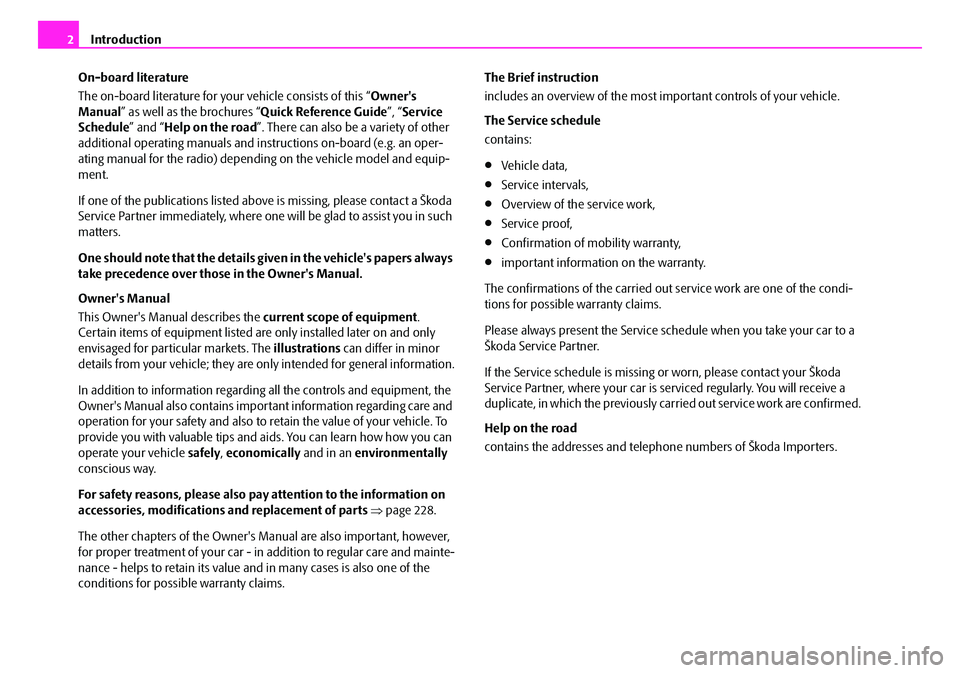
Introduction
2
On-board literature
The on-board literature for your vehicle consists of this “ Owner's
Manual ” as well as the brochures “ Quick Reference Guide”, “Service
Schedule ” and “Help on the road ”. There can also be a variety of other
additional operating manuals and instructions on-board (e.g. an oper-
ating manual for the radio) depending on the vehicle model and equip-
ment.
If one of the publications listed above is missing, please contact a Škoda
Service Partner immediately, where one wi ll be glad to assist you in such
matters.
One should note that the details give n in the vehicle's papers always
take precedence over those in the Owner's Manual.
Owner's Manual
This Owner's Manual describes the current scope of equipment.
Certain items of equipment listed ar e only installed later on and only
envisaged for particular markets. The illustrations can differ in minor
details from your vehicle; they are only intended for general information.
In addition to information regarding all the controls and equipment, the
Owner's Manual also contains import ant information regarding care and
operation for your safety and also to retain the value of your vehicle. To
provide you with valuable tips and aids. You can learn how how you can
operate your vehicle safely, economically and in an environmentally
conscious way.
For safety reasons, please also pay attention to the information on
accessories, modifications and replacement of parts ⇒ page 228.
The other chapters of the Owner's Manual are also important, however,
for proper treatment of your car - in addition to regular care and mainte-
nance - helps to retain its value and in many cases is also one of the
conditions for possible warranty claims. The Brief instruction
includes an overview of the most important controls of your vehicle.
The Service schedule
contains:
•Vehicle data,
•Service intervals,
•Overview of the service work,
•Service proof,
•Confirmation of mo
bility warranty,
•important information on the warranty.
The confirmations of the carried out service work are one of the condi-
tions for possible warranty claims.
Please always present th e Service schedule when you take your car to a
Škoda Service Partner.
If the Service schedule is missing or worn, please contact your Škoda
Service Partner, where your car is serviced regularly. You will receive a
duplicate, in which the previously carried out service work are confirmed.
Help on the road
contains the addresses and telephone numbers of Škoda Importers.
NKO B6 20.book Page 2 Wednesday, March 26, 2008 3:15 PM
Page 14 of 272
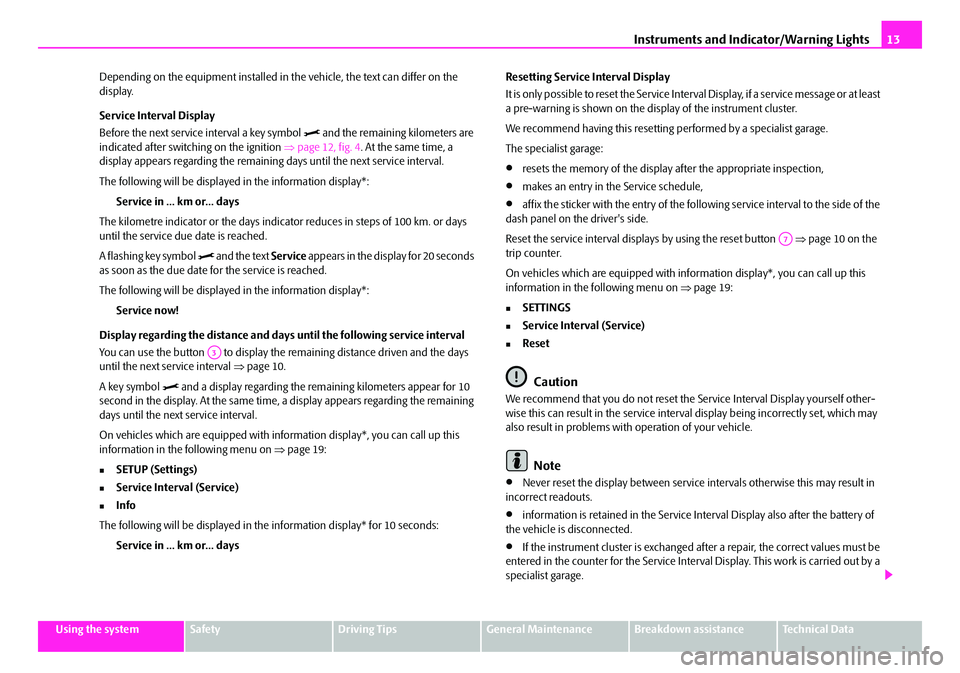
Instruments and Indicator/Warning Lights13
Using the systemSafetyDriving TipsGeneral MaintenanceBreakdown assistanceTechnical Data
Depending on the equipment installed in th
e vehicle, the text can differ on the
display.
Service Interval Display
Before the next service interval a key symbol
and the remaining kilometers are
indicated after switching on the ignition ⇒page 12, fig. 4 . At the same time, a
display appears regarding the remaining days until the next service interval.
The following will be displayed in the information display*:
Service in ... km or... days
The kilometre indicator or the days indica tor reduces in steps of 100 km. or days
until the service due date is reached.
A flashing key symbol
and the text Service appears in the display for 20 seconds
as soon as the due date for the service is reached.
The following will be displayed in the information display*:
Service now!
Display regarding the distance and days until the following service interval
You can use the button to display the remaining distance driven and the days
until the next service interval ⇒ page 10.
A key symbol
and a display regarding the remaining kilometers appear for 10
second in the display. At the same time , a display appears regarding the remaining
days until the next service interval.
On vehicles which are equipped with info rmation display*, you can call up this
information in the following menu on ⇒page 19:
�„SETUP (Settings)
�„Service Interval (Service)
�„Info
The following will be displayed in the information display* for 10 seconds: Service in ... km or... days Resetting Service Interval Display
It is only possible to reset the Service Interval Display, if a service message or at least
a pre-warning is shown on the display of the instrument cluster.
We recommend having this resetting
performed by a specialist garage.
The specialist garage:
•resets the memory of the display after the appropriate inspection,
•makes an entry in the Service schedule,
•affix the sticker with the entry of the following service interval to the side of the
dash panel on the driver's side.
Reset the service interval displays by using the reset button ⇒page 10 on the
trip counter.
On vehicles which are equipped with info rmation display*, you can call up this
information in the following menu on ⇒page 19:
�„SETTINGS
�„Service Interval (Service)
�„Reset
Caution
We recommend that you do not reset the Service Interval Display yourself other-
wise this can result in the service interval display being incorrectly set, which may
also result in problems with operation of your vehicle.
Note
•Never reset the display between service intervals otherwise this may result in
incorrect readouts.
•information is retained in the Service Interval Display also after the battery of
the vehicle is disconnected.
•If the instrument cluster is exchanged after a repair, the correct values must be
entered in the counter for the Service Interva l Display. This work is carried out by a
specialist garage.
A3
A7
NKO B6 20.book Page 13 Wednesday, March 26, 2008 3:15 PM
Page 15 of 272
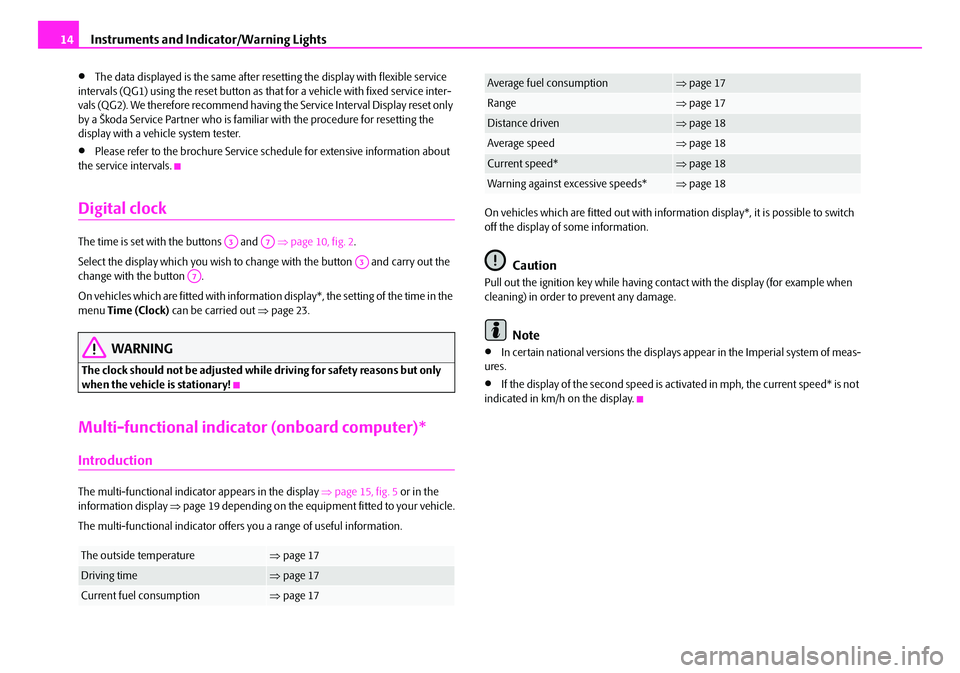
Instruments and Indicator/Warning Lights
14
•The data displayed is the same after resetting the display with flexible service
intervals (QG1) using the reset button as th at for a vehicle with fixed service inter-
vals (QG2). We therefore recommend having the Service Interval Display reset only
by a Škoda Service Partner who is familiar with the procedure for resetting the
display with a vehicle system tester.
•Please refer to the brochure Service schedule for extensive information about
the service intervals.
Digital clock
The time is set with the buttons and ⇒page 10, fig. 2 .
Select the display which you wish to ch ange with the button and carry out the
change with the button .
On vehicles which are fitted with informatio n display*, the setting of the time in the
menu Time (Clock) can be carried out ⇒page 23.
WARNING
The clock should not be adjusted while driving for safety reasons but only
when the vehicle is stationary!
Multi-functional indica tor (onboard computer)*
Introduction
The multi-functional indicator appears in the display ⇒page 15, fig. 5 or in the
information display ⇒page 19 depending on the equipment fitted to your vehicle.
The multi-functional indicator offers you a range of useful information. On vehicles which are fitted out with information display*, it is possible to switch
off the display of some information.
Caution
Pull out the ignition key while having cont
act with the display (for example when
cleaning) in order to prevent any damage.
Note
•In certain national versions the displays appear in the Imperial system of meas-
ures.
•If the display of the second speed is activated in mph, the current speed* is not
indicated in km/h on the display.
The outside temperature⇒ page 17
Driving time⇒page 17
Current fuel consumption⇒page 17
A3A7
A3A7
Average fuel consumption⇒page 17
Range⇒page 17
Distance driven⇒page 18
Average speed⇒page 18
Current speed*⇒page 18
Warning against excessive speeds*⇒page 18
NKO B6 20.book Page 14 Wednesday, March 26, 2008 3:15 PM
Page 185 of 272

Intelligent Technology
186
Diesel particle filter* (diesel engine)
In the diesel particle filter the resulting soot particles are collected
and burnt during the combustion of diesel fuel.
Code 7GG on the vehicle data sticker ⇒fig. 178 indicates that your
vehicle is equipped with a diesel particle filter. The vehicle data sticker is
located on the floor of the luggage compartment and is also stated in the
Service schedule.
The diesel particle filter filters the soot particles completely from the exhaust. The
soot is collected in the diesel particle filter and burnt regularly. To assist this proce-
dure, we recommend not to drive regularly over short distances.
If the diesel particle filter is clogged or there is a fault, it is indicated by the warning
light
.
WARNING
•The diesel particle filter achieves very high temperatures. Therefore do
not park at points where the hot filter comes into direct contact with dry
grass or other combustible materials - risk of fire!
•Never use additional underbody protection or corrosion-protection
agents for the exhaust pipes, catalytic converters, diesel particle filter or
heat shields. When the engine reaches its operating temperature, these
substances might ignite - risk of fire.
Note
When using diesel fuel with high sulphur content the life of the diesel particle filter
is clearly reduced. A specialist garage wi ll be able to tell you which countries use
only diesel fuel with high sulphur content.
Fig. 178 Vehicle data sticker
WARNING (continued)
NKO B6 20.book Page 186 Wednesday, March 26, 2008 3:15 PM
Page 189 of 272
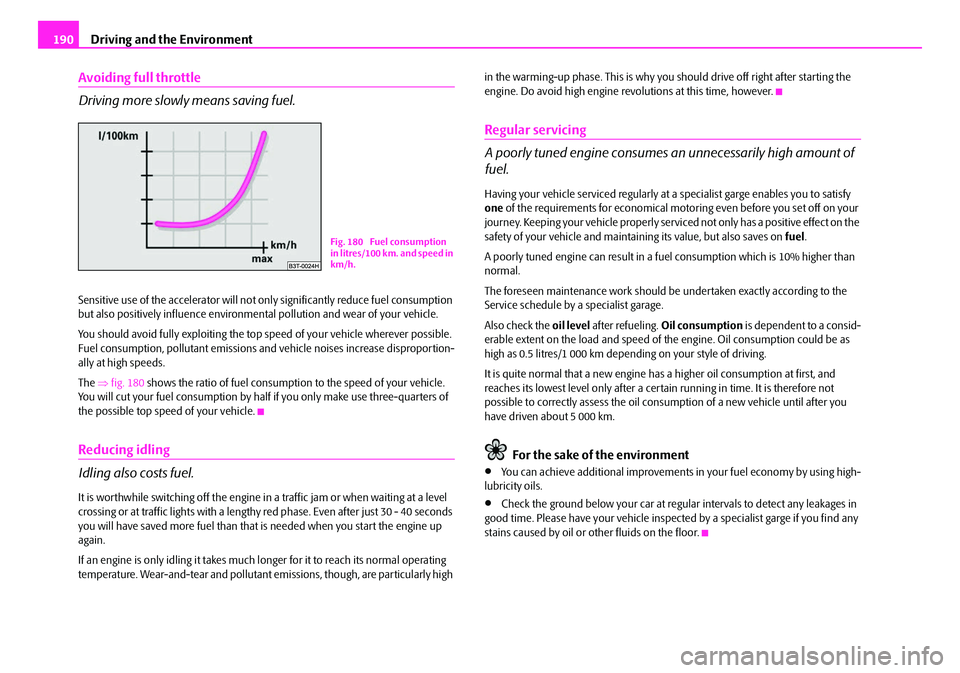
Driving and the Environment
190
Avoiding full throttle
Driving more slowly means saving fuel.
Sensitive use of the accelera tor will not only significantly reduce fuel consumption
but also positively influence environmen tal pollution and wear of your vehicle.
You should avoid fully exploi ting the top speed of your vehicle wherever possible.
Fuel consumption, pollutant emissions and vehicle noises increase disproportion-
ally at high speeds.
The ⇒fig. 180 shows the ratio of fuel consumption to the speed of your vehicle.
You will cut your fuel consumption by half if you only make use three-quarters of
the possible top speed of your vehicle.
Reducing idling
Idling also costs fuel.
It is worthwhile switching off the engine in a traffic jam or when waiting at a level
crossing or at traffic lights with a length y red phase. Even after just 30 - 40 seconds
you will have saved more fuel than that is needed when you start the engine up
again.
If an engine is only idling it takes much longer for it to reach its normal operating
temperature. Wear-and-tear and pollutant em issions, though, are particularly high in the warming-up phase. This is why you
should drive off right after starting the
engine. Do avoid high engine revolutions at this time, however.
Regular servicing
A poorly tuned engine consumes an unnecessarily high amount of
fuel.
Having your vehicle serviced regularly at a specialist garge enables you to satisfy
one of the requirements for economical moto ring even before you set off on your
journey. Keeping your vehicle properly servic ed not only has a positive effect on the
safety of your vehicle and maintaining its value, but also saves on fuel.
A poorly tuned engine can result in a fu el consumption which is 10% higher than
normal.
The foreseen maintenance work should be undertaken exactly according to the
Service schedule by a specialist garage.
Also check the oil level after refueling. Oil consumption is dependent to a consid-
erable extent on the load and speed of the engine. Oil consumption could be as
high as 0.5 litres/1 000 km depending on your style of driving.
It is quite normal that a new engine ha s a higher oil consumption at first, and
reaches its lowest level only after a certain running in time. It is therefore not
possible to correctly assess the oil cons umption of a new vehicle until after you
have driven about 5 000 km.
For the sake of the environment
•You can achieve additional improvements in your fuel economy by using high-
lubricity oils.
•Check the ground below your car at regula r intervals to detect any leakages in
good time. Please have your vehicle inspected by a specialist garge if you find any
stains caused by oil or other fluids on the floor.
Fig. 180 Fuel consumption
in litres/100 km. and speed in
km/h.
NKO B6 20.book Page 190 Wednesday, March 26, 2008 3:15 PM
Page 204 of 272

Fuel205
Using the systemSafetyDriving TipsGeneral MaintenanceBreakdown assistanceTechnical Data
Fuel
Petrol
Grades of petrol
There are various grades of petrol. Please read ⇒page 255, “Technical Data” in
order to know which grade of petrol your vehicle requires. You will also find the
same information affixed to the inside of the fuel filler flap of your vehicle
⇒ page 206, fig. 184 .
A distinction is made between unleaded an d leaded petrol. All Škoda vehicles with
petrol engines are equipped with a catalyti c converter and must therefore be only
driven with unleaded petrol . Unleaded petrol complies with the standard
DINEN228 .
The individual grades of petr ol are distinguished by their octane number (RON).
Please adopt the following procedure if th e grade of petrol which you normally use
is not be available in exceptional circumstances.
•Engines which need unleaded premium petrol 95 RON can also be run on
unleaded regular petrol 91 RON. This does, however, result in a slight loss in
performance.
If, in an emergency, the only fuel availa ble is one which has a lower octane number
than that required by the engine then only drive at medium engine speeds and
lower engine loadings.
You can make unlimited use of fuel which has a higher octane number than that
required by the engine. There will, howeve r, be no advantages gained by this in
terms of engine performa nce and fuel consumption!
The handling, performance and life of your engine are determined to a significant
extent by the quality of the fuel. Do not use any petrol additives. Use a fuel
complying with the standard.
You can find further information on refuelling ⇒page 206, “Refuelling”.
Caution
•Filling the tank even only once with leaded petrol will result in the catalytic
converter being destroyed.
•Operating the engine with petrol of a low octane number can result in engine
damage at high revolutions or severe engine loading.
Diesel
Diesel fuel
Your vehicle can be operated with diesel fuel, which complies with the standard
DIN EN 590 .
Fuel additives
You must not use fuel additives, so-called “flow improvers” (petrol and similar
products) in diesel fuel.
If the quality of the diesel fuel is poor, it is then necessary to drain the fuel filter
more often than stated in the Service schedule.
You can find information on refuelling ⇒page 206, “Refuelling”.
Caution
•Use a fuel which complies with the standard DINEN590. Filling the tank even
only once, which does not comply with th e standard, can result in damage to the
fuel system.
•Water which has collected in the fuel fi lter can result in engine problems.
•Your vehicle is not adapted for use of biofuel (RME), therefore this fuel must not
be refuelled and driven. Using this fuel (RME) can lead to damage to the engine or
the fuel system.
NKO B6 20.book Page 205 Wednesday, March 26, 2008 3:15 PM
Page 211 of 272
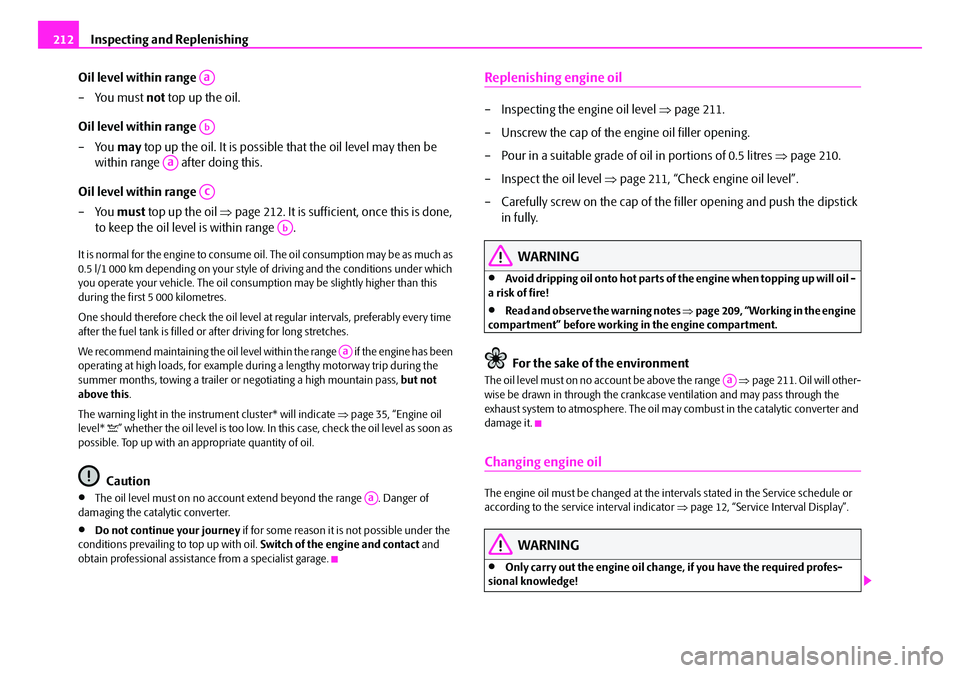
Inspecting and Replenishing
212
Oil level within range
–You must not top up the oil.
Oil level within range
–You may top up the oil. It is possible that the oil level may then be
within range after doing this.
Oil level within range
–You must top up the oil ⇒page 212. It is sufficient, once this is done,
to keep the oil level is within range .
It is normal for the engine to consume oil. The oil cons umption may be as much as
0.5 l/1 000 km depending on your style of driving and the conditions under which
you operate your vehicle. The oil consumpt ion may be slightly higher than this
during the first 5 000 kilometres.
One should therefore check the oil level at regular intervals, preferably every time
after the fuel tank is filled or after driving for long stretches.
We recommend maintaining the oil level within the range if the engine has been
operating at high loads, for example during a lengthy motorway trip during the
summer months, towing a trailer or negotiating a high mountain pass, but not
above this .
The warning light in the instrument cluster* will indicate ⇒page 35, “Engine oil
level* ” whether the oil level is too low. In this case, check the oil level as soon as
possible. Top up with an a ppropriate quantity of oil.
Caution
•The oil level must on no account ex tend beyond the range . Danger of
damaging the catalytic converter.
•Do not continue your journey if for some reason it is not possible under the
conditions prevailing to top up with oil. Switch of the engine and contact and
obtain professional assistance from a specialist garage.
Replenishing engine oil
– Inspecting the engine oil level ⇒page 211.
– Unscrew the cap of the engine oil filler opening.
– Pour in a suitable grade of oil in portions of 0.5 litres ⇒page 210.
– Inspect the oil level ⇒page 211, “Check engine oil level”.
– Carefully screw on the cap of the filler opening and push the dipstick in fully.
WARNING
•Avoid dripping oil onto hot parts of the engine when topping up will oil -
a risk of fire!
•Read and observe the warning notes ⇒page 209, “Working in the engine
compartment” before working in the engine compartment.
For the sake of the environment
The oil level must on no account be above the range ⇒page 211. Oil will other-
wise be drawn in through the crankcase ventilation and may pass through the
exhaust system to atmosphere. The oil ma y combust in the catalytic converter and
damage it.
Changing engine oil
The engine oil must be changed at the intervals stated in the Service schedule or
according to the service interval indicator ⇒page 12, “Service Interval Display”.
WARNING
•Only carry out the engine oil change, if you have the required profes-
sional knowledge!
Aa
Ab
Aa
Ac
Ab
Aa
Aa
Aa
NKO B6 20.book Page 212 Wednesday, March 26, 2008 3:15 PM
Page 255 of 272

Technical Data
256
Vehicle data sticker
The vehicle data sticker ⇒page 255, fig. 231 is located on the floor of the luggage
compartment and is also stated in the Service schedule.
The vehicle data sticker co ntains the following data:
Vehicle identification number (VIN).
Vehicle type.
Gearbox code, paint number, interior equipment number, engine output,
engine code.
Partial description of the vehicle.
7GG - vehicles with DPF ⇒page 186.
Vehicle identification number (VIN)
The vehicle identification num ber - VIN (vehicle body number) is stamped into the
engine compartment on the right hand shoc k absorber dome. This number is also
located on a sign on the lower left hand edge below the windscreen (together with
a VIN bar code).
Engine number
The engine number is stamped into the engine block.
Type plate (production plate)
Is located on the left midd le pillar of the bodywork.
Homologation sign
The homologation sign is located on the lo ck carrier. Vehicles for certain countries
do not have an homologation sign.
Sticker on inside of fuel filler flap
The sticker is affixed to the inside of the fuel filler flap. The sticker contains the
following data:
•The prescribed types of fuel,
•Tyre si z e,
•Tyre pressure.
Fuel consumption according to the regulations
(99/100/EU)
Depending on the range of the special equipment, style of driving, traffic situation,
weather influences and vehi cle condition, the consumption values which in prac-
tice result when using the vehicle ca n deviate from the indicated values.
Urban traffic
The consumption measurement in urban traf fic begins with starting of the cold
engine. Afterwards the normal urban traffic is simulated.
Non-urban traffic
For the consumption measurement in non-ur ban traffic the vehicle, as in daily
motoring, is accelerated and braked several times in all gears. The vehicle speed
changes within the range from 0 to 120 km/h.
Combined traffic
The consumption value in the combined traf fic consists of 37% from the value for
the urban traffic and of 63% from the value for the non-urban traffic.
Note
•Please note that the information stated in the official vehicle registration
documents always takes priority.
A1
A2
A3
A4
A5
NKO B6 20.book Page 256 Wednesday, March 26, 2008 3:15 PM